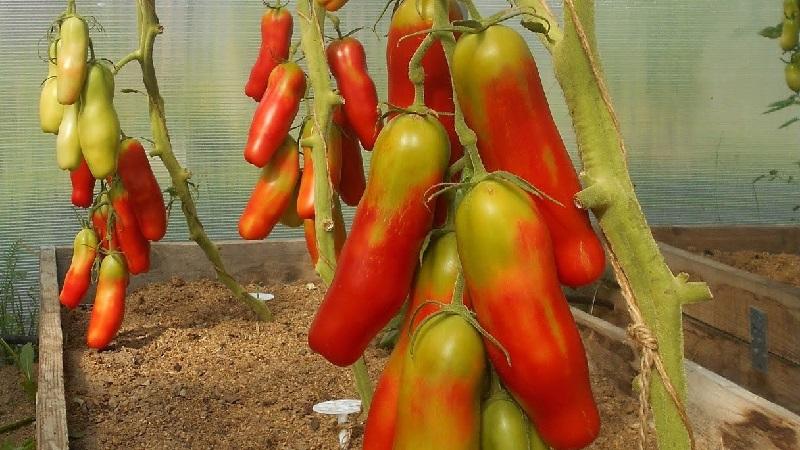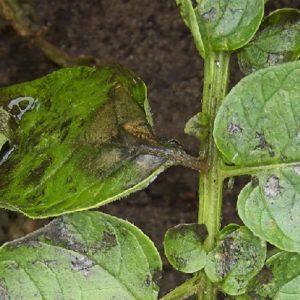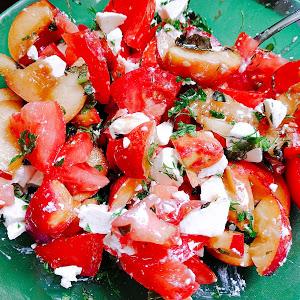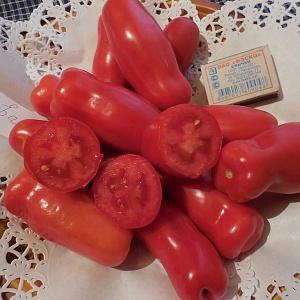Mid-season, high-yielding and unusually shaped Casanova tomato: reviews from farmers and growing tips
The Casanova tomato is winning the hearts of gardeners across the country. Not only does it grow amazingly beautiful, but the taste of the vegetable is sweet and juicy. It is difficult to imagine that previously all tomatoes were considered poisonous. Today, various dishes are prepared from tomatoes, including the Casanova variety. Let's look at how to grow a good crop of Casanova tomatoes on your plot.
Description of the variety
The variety is indeterminate and high-yielding. It is recommended to grow Casanova in the greenhouse, especially in central Russia. The vegetable is sown in March, the first fruits ripen in early July. Summer residents harvest the best harvest when they form a bush with 2 stems.
Distinctive features
Tomato bushes are not limited in growth, so the plant needs to be tied up. On average, the height of one bush is about 2 m. They grow branched, with dense foliage. The root system develops powerful. The best predecessors are pumpkin or legumes. It is not recommended to plant tomatoes after potatoes or peppers.
Characteristics of tomatoes, yield
The tomato has an elongated shape, outwardly reminiscent of a small banana or zucchini. The average length is about 20 cm. The peel is glossy and moderately dense, so the tomatoes are stored for a long time. One fruit weighs about 180-200 g. Up to 5 tomatoes are tied on a bunch.
Casanova has a rich red color and a classic aroma. There are practically no seeds. Casanova has a sweet taste, not watery.Commercial quality is maintained even after long-distance transportation. From 1 sq. m harvest about 12 kg of ripe tomatoes.

How to grow seedlings
The variety is planted mainly in seedlings. This makes it easier for seedlings to take root in the ground. Planting of seedlings takes place approximately 50-60 days before planting in the ground.
Seed preparation
Experienced gardeners advise buy seeds in the store, so the likelihood of the crop becoming infected with infections is much less. It is recommended to purchase seed material only from trusted sellers, avoiding accidental purchases.
First, the seeds are disinfected. The easiest way is to spread the seeds under the sun for a week. The sun's rays will warm the seeds well and destroy dangerous bacteria on their surface.
Then seeds germinate. To do this, place them in a damp gauze bag and put them in a warm place. Germination shows the germination rate of seeds and helps them develop strong immunity to diseases and insects.
Container and soil
 Any clean and dry small container is suitable for seedlings. If there is no special container, for example, plastic cups will do. The most successful option is peat pots. They are affordable, made from environmentally friendly material and retain moisture well. When transplanting, seedlings can be planted directly in pots.
Any clean and dry small container is suitable for seedlings. If there is no special container, for example, plastic cups will do. The most successful option is peat pots. They are affordable, made from environmentally friendly material and retain moisture well. When transplanting, seedlings can be planted directly in pots.
It is better to purchase soil for seedlings at a gardening store. Ready-made formulations are pre-disinfected and safe, enriched with vitamins and meet the required acidity level.
The most popular mixture for seedlings is “Universal” soil. It is sold in bags of 500 g or 1 kg.
Sowing
It is better to start the sowing procedure in the morning.Pour soil into a container and make small holes about 1-2 cm deep in it. Place a seed in each hole and cover it with soil on top. Don’t forget to water the soil with warm, settled water after sowing.
Growing and care
Grow seedlings in the warmest and brightest place in the house, for example, on a windowsill. The optimal temperature is at least 22 degrees. Sprouts love a lot of light. If it is not enough, arrange additional lighting with fluorescent lamps. Avoid drafts, as the plants may become sick.
Important! Never pour cold tap water on your Casanova. This is a direct threat to the health and growth of bushes.
Water the seedlings every 7-9 days. Be extremely careful, do not allow the soil to become waterlogged. It is better to use a regular pipette for watering - with its help, moisture will get directly under the root, bypassing the sprouts that have not yet matured.
After 1-2 weeks, the seedlings are fertilized. Alternate mineral and organic feeding. Tomatoes are very fond of ammonium nitrate, saline solution, liquid bird droppings, and nettle infusion. It would also be useful to use growth stimulants, for example, Fitosporin+. The drug saturates the sprouts with macro- and microelements, ensuring a rich harvest in the future.
How to grow tomatoes
Tomatoes are planted in early July. Casanova is picky about soil composition, so give the tomato a spacious and nutritious plot of land. Before planting, be sure to disinfect the soil. A solution of potassium permanganate is suitable for this. Water the beds with it, thereby protecting the bushes from insect pests.
Landing
The optimal distance between Casanova bushes should be at least 50 cm. The plant is powerful, the bushes should not interfere with each other.After planting, you need to install a wooden peg near each bush. It is necessary for future gartering of the plant to the support. Otherwise, the stems and trusses may break under the weight of the ripe tomatoes.
Important! If several varieties of tomatoes grow on the site at once, place a sign near each with the name of the tomato and the date of planting to take into account all the nuances of care.
Care
Caring for the Casanova variety consists of observing the following rules of agricultural technology:
- Loosen the beds every week. This technique helps the plant receive more oxygen. Loosening is especially important before watering and fertilizing.
- Removing weeds. They settle in tomato beds and live off vegetables. Remove weeds every 10 days. If the summer was rainy and foggy, then more often.
- Regular watering. When watering the bushes, try to avoid getting water on the stems and leaves. High humidity increases the risk of developing fungal diseases. The optimal water temperature should be at least 18 degrees. On average, one bush uses about 0.5 liters of water.
- Fertilizer application. Tomatoes love nitrogen-containing substances, so use urea or saltpeter. This is especially true during the flowering and fruiting period. Observe precise dosages - excess nitrogen harms tomatoes.
- If Casanova grows in a greenhouse, do not forget to ventilate the structure. To do this, simply open the doors or windows.
Features of cultivation and possible difficulties
Casanova variety requires mandatory bush formation. Most often, Casanova is formed into 1-2 stems, the side ones are removed. About 7-10 clusters are left on the main stem, and the top is pinched to stop the growth of the bush.With this forming, the development of tomatoes is accelerated by 1-2 weeks. The risk of plant disease is also reduced as the stem and leaves are raised above the ground.
Another important stage of formation is the removal of stepchildren. This is especially important for the northern regions. Vegetables need time to ripen in a short time, and for this the load on the bush should not be very large. A large number of stepsons and leaves leads to excessive planting density.
Diseases and pests
 Casanova is resistant to many diseases, but sometimes they appear due to external factors or errors in care. First of all, beware late blight. This is the most common fungus and is almost impossible to get rid of. Appears in the form of brown and brown spots on the leaves. If the disease is not treated, the bushes will dry out and die. Fungal spores can be stored in soil, seeds, and the remains of old plants, which is why it is so important to disinfect the soil.
Casanova is resistant to many diseases, but sometimes they appear due to external factors or errors in care. First of all, beware late blight. This is the most common fungus and is almost impossible to get rid of. Appears in the form of brown and brown spots on the leaves. If the disease is not treated, the bushes will dry out and die. Fungal spores can be stored in soil, seeds, and the remains of old plants, which is why it is so important to disinfect the soil.
"Relative" of late blight - septoria - also affects stems and leaves. Small white spots on the leaf blade help identify septoria. To prevent the appearance of fungi, treat tomato beds with soapy water. It creates a protective barrier on the surface of the sheet.
From insects you should be wary of whiteflies, mole crickets, spider mites and aphids. Pests eat either the plant's roots, stems or fruits. To prevent this, treat the bushes with Bordeaux mixture even at the planting stage.
The nuances of growing in open ground and in a greenhouse
When growing Casanova in a greenhouse, it is better to treat not only the ground with potassium permanganate, but also hard surfaces inside the structure before planting. Also monitor the watering schedule.If the summer is hot and rainy, reduce their number. Pay attention to the appearance of the bushes; at the first signs of disease, take immediate action.
When planting a crop in open ground, avoid the presence of groundwater near it. It is also better if the vegetables grow in a windless place. Ideal neighbors for tomatoes are legumes, garlic, onions, and herbs. If the summer is cold and rainy, cover the tomatoes with film. As soon as the weather returns to normal, remove the film.
Harvesting and application
 Casanova is harvested as it ripens. Pick tomatoes carefully, without harming other fruits or stems. The good thing about this variety is that the tomatoes can ripen on their own after picking.
Casanova is harvested as it ripens. Pick tomatoes carefully, without harming other fruits or stems. The good thing about this variety is that the tomatoes can ripen on their own after picking.
The fruiting period is long, so you can enjoy fresh vegetables for a long time.
Tomatoes are used in cooking: preparing soups, side dishes or salads. Vegetables contain a large amount of vitamins and minerals; they are indispensable for proper and dietary nutrition.
Housewives also use Casanova in preparations for the winter. Marinated and canned tomatoes do not lose their beneficial properties after processing.
Advantages and disadvantages of the variety
Like other varieties, Casanova has its advantages and disadvantages. Among the advantages are noted:
- original appearance;
- great taste;
- possibility of growing in different climatic conditions;
- versatility in application;
- immunity to disease;
- utility.
Among the disadvantages, gardeners highlight the need for the formation of a bush and the demands on the composition of the soil.
Farmer reviews
There is no clear opinion among gardeners regarding the Casanova variety. Some consider it very attractive and tasty, others point out some shortcomings.
 Alena, Penza: “I’m a big fan of unusual tomatoes. In addition to its original appearance, I appreciate the Casanova variety for its excellent taste. I make snacks and salads from vegetables, and also prepare tomato juice.”
Alena, Penza: “I’m a big fan of unusual tomatoes. In addition to its original appearance, I appreciate the Casanova variety for its excellent taste. I make snacks and salads from vegetables, and also prepare tomato juice.”
Elena, Tyumen: “I only recently heard about the Casanova variety. I planted it on my plot, and it turned out that it is an unpretentious and beautiful variety. The bushes are tall, but neat. I tied it to pegs, it didn’t cause any problems. I give the variety a solid “5”.
Maxim, Moscow: “I’m a big fan of indeterminate varieties, but I wasn’t very impressed with Casanova. The bunches formed weakly, the tomatoes set slowly. They taste no different from most common varieties.”
Conclusion
Scientists have proven that tomato has excellent mood-improving properties because it contains serotonin. Therefore, many vegetable growers grow a wide variety of tomatoes in their gardens.
The Casanova variety is unpretentious in care, resistant to diseases and pleases with a good harvest.